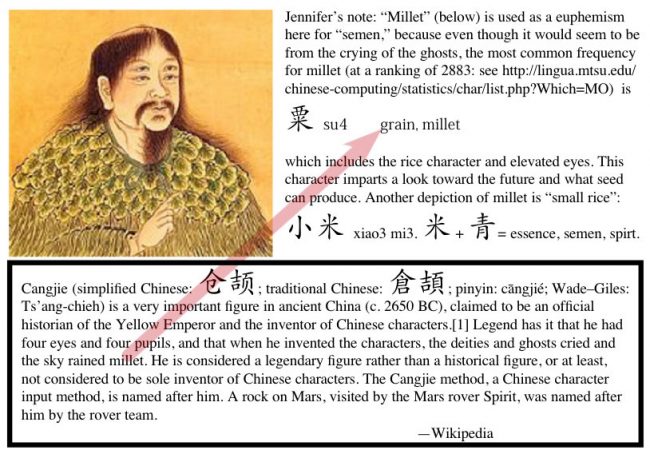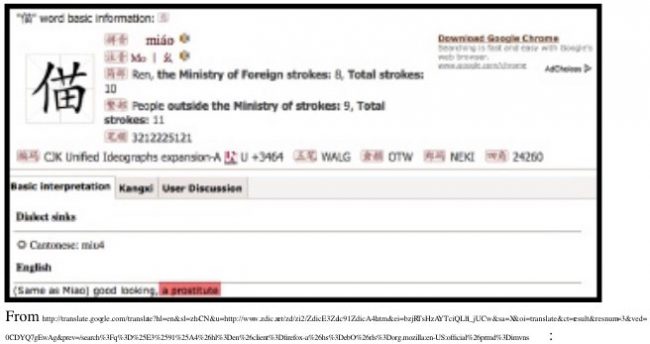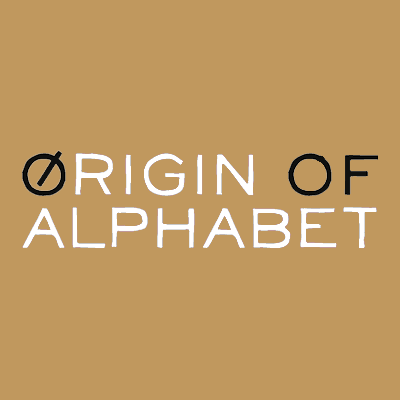Mandarin I Berkeley Extension Class – 11 – Nov. 22, 2011
425 Market Street
San Francisco, CA
Professor: Virginia Mau
Homework: Menu
Include:Name of restaurant
Phone
Hours
Food inside with prices
Ms. Mau is going to be the customer and give us a hard time. We are the wait staff.

佃
tian2 = landlord
㑤
miao2 = “(same as 媌 ) good looking, a prostitute”: Chinese Text Project, Mandarin Text Project, Wik-tionary, Cojak.org

“Ministry of Foreign Strokes” sounds a lot like the description of a prostitute’s job. Since Ms. Mauclaimed that this character didn’t exist, I’m spending some time to show that it in fact does, and it has alengthy record.
房东
fang2 dong1 = landlord (“room or house east”: does “east” mean “lord” because that’s where the sunrises?)
肉
rou = meat, flesh
類/类
lei4 = kind; type; class; category; similar; like; to resemble (Jennifer’s note: Again with the rice character. It’s used as a metaphor for semen, seed, and similarity. Did you notice that rice is also in “come” lai2
来 ? Knowing this will help you retain meanings.)
Ms. Mau: “Tiger tastes like pork.” See? We all use metaphor.
Geary and 17th : China Creations makes Chinese desserts
几个人?= how many people?
ji3 ge ren2
几位
ji3 wei4 = ① several people (honorific) ② Ladies and Gentlemen! (talaqa.com) (Ms. Mausaid, “How many? (more polite)” (Ms. Mau says: Do not need “ren2” because “side manradical” is present in wei4 位)
小姐
xiao jie = young miss
三陪小姐
san1 pei2 xiao3 jie = “ladies of the three accompaniments”). In theory, the “three accompaniments” arechatting, drinking and dancing with their clients. In practice, the “three accompaniments” more often re-fers to dancing with, drinking with, and being publicly groped by their clients. These women often beginby allowing their clients to fondle or intimately caress their bodies, then if the client is eager, will engagein sexual intercourse.” Wikipedia: Prostitution in the People’s Republic of China
杯
bei1 = cup
瓶
ping2 = bottle
罐
guan4 = can, jar, pot
一壶茶
xi hu cha = one pot of tea
来一杯酒
lai2 yi1 bei1 jiu3 = bring one cup of wine
来一杯水
lai2 yi1 bei1 shui3 = bring one cup of water
干杯
gan1 bei1 = cheers (“dry cup”)
有菜单吗?
you2 cai4 dan1 ma? = you have menu? (Remember cai is pronounced tsai.)
请给我一份
qing1 gei3 wo3 yi1 fen4 = please give me one piece [of table setting]
给
gei3 = give, to (pronounced “KKay! extra K means hit beginning extra hard)
份
fen4 = (a measure word for gifts, copies of a newspaper); copy (of newspaper, magazine, etc.);share; portion; part; (a measure word)
能给我份菜单?
neng2 gei3 wo3 fen4 cai4 dan1 = Are you able to give me the menu?
菜
dan1 = ① bill ② list ③ form ④ single ⑤ only ⑥ sole ⑦ odd number
请来下
qing1 lai2 xia4 = please come
你要吃点二什么?
ni3 yao3 chi1 dian3 er4 shen2 me? = you want to eat for a little bit?
吃
chi1 = ① to eat ② to have one’s meal ③ to eradicate ④ to destroy ⑤ to absorb ⑥ to suffer⑦ to exhaust
点
dian3 = ① point ② dot ③ speck ④ drop ⑤ decimal point ⑥ point of a scale ⑦ point in atheory or argument ⑧ downwards-right convex character stroke ⑨ a little (usually 一點|一点) ⑩ a jot 11) beat (of percussion instrument) 12) to draw a dot 13) to touch slightly 14) todrip 15) classifier for items 16) classifier for small indeterminate quantities 17) to nod 18) toselect item from a list 19) to order (food in a restaurant); to count ⑴ o’clock ⑵ one fifth of a two hour watch (old) ⑶ hour ⑷ point of time ⑸ iron bell (used to mark time) ⑹ pastry ⑺dimsum
要什么?
yao shen me = fast food ***NOT SURE THIS IS CORRECT
外带
wai4 dai4 = takeout (fast food) according to Talaqa.com
来点二
lai2 dian3 er = Please come for a little
吃饭
chi1 fan4 = to eat a meal
饭
fan4 = ① food ② cuisine ③ cooked rice ④ meal
今天的汤什么
jin1 tian1 de tang1 shen2 me = What is today’s soup? (Note that “soup” 汤 has the water radical and something that looks like an animal, which would connote a broth.)
新鲜
xin1 xian1 = new。 fresh
请结账
qing jie2 zhang4 = please bill/check/agreement
结
jie1 = ① to bear fruit ② to produce ③ firm ④ solid
结
jie1 = ① to bear fruit ② to produce ③ firm ④ solid ① knot ② sturdy ③ bond ④ to tie ⑤ tobind ⑥ to check out (of a hotel)
账
zhang4 = account (pronounced “JJong”)
味道怎么样
wei4 dao4 zen3 me yang4? = How’s the taste? (pronounced “way tao se me yang”)
道
dao4 = ① direction ② way ③ road ④ path ⑤ principle ⑥ truth ⑦ morality ⑧ reason ⑨skill ⑩ method 11) Dao (of Daoism) 12) to say 13) to speak 14) to talk 15) classifier for longthin stretches, rivers, roads etc 16) province (of Korea do 17), and formerly Japan dō)
好味道
hao3 wei4 dao4 = good
味道不好
wei4 dao4 bu4 hao3 = not good
| 甜 |
咸 |
苦 |
辣 |
酸 |
淡 |
tian2
sweet |
xian2
salty |
ku3
bitter |
la4
spicy |
suan1
sour |
dan4
plain |
太 tai4 = ① highest ② greatest ③ too (much) ④ very ⑤ extremely (and represents abreast with milk, as in taitai 太 太 “Mrs.”)
tian = di le
(Not sure about these. No definitions given or characters written on the board by Ms. Mau.)
熟
shou2/shu2 = ① cooked (of food) ② ripe (of fruit) ③ mature (of seeds) ④ familiar ⑤ skilled⑥ done
生
sheng1 = ① to be born ② to give birth ③ life ④ to grow ⑤ raw, uncooked
生不生
sheng1 bu4 sheng1? (Newly weds with rice balls, double meaning is is raw? is birth ahead?)wo sheng – Last Emperor never had children - could not find this info or phrase
都小?
dou1 xiao xian = (not sure what this is)
服务费
fuwu fei4 = service fee
费
fei4 = ① to cost ② to spend ③ fee ④ wasteful ⑤ expenses
船
chuan2 = boat
床
chuang2 = bed
船费
chuan2 fei4 = fares
床费
chuang2 fei4 = bed fee (don’t say this; this is the joke if you mispronounce chuan2)
车费
che1 fei4 = transportation fee
香
xiang1 = smells good
香港
xiang1 gang3 = Hong Kong (“smells good harbor”)
臭
chou4 = stinky
臭豆腐
chou4 dou4 fu = stinky tofu Jackson & Kearney. Only open on weekend; too many complaints weekdays
寿司 = sushi (phonetic)
shou4 si
筷子
kuai4 zi = chopsticks
叉子
cha1 zi = fork
刀子
dao1 zi = knife
匙子
shi3/chi4 zi = spoon as well as
勺
shao2 = spoon
盘
pan2 = dish
碗
wan3 = bowl
餐纸
can1 zhi3 = napkins (“meal paper”)
餐巾
can1 jin1 = napkins (“meal cloth”)
餐/飡
can1 = eat, meal (second character is “semantic variant” as opposed to “simplified”)
水果
shui guo3 = fruit
苹果
ping1 guo3 = apple
芒果
mang1 guo3 = mango
橘子 = tangerine
桔子
ju2 zi = tangerine (more popular character)
金桔子
jin1 ju1 zhi = golden tangerine
结
jie3 = bear (fruit) / to produce / firm/ solid
吉= lucky; auspicious; propitious
ji2
橙
cheng2 = orange
桃子
tao2 zi = peach
利
li2 = pear
李子
li3 zi = plum
荔枝
lì zhī = litchi fruit
提子
ti2 zi = grapes (hard to peel)
葡萄
pu2 tao2 = grapes (bigger, NE China)
西瓜
xi1 gua1 = watermelon
蜜瓜
mi3 gua1 = honeydew melon
草莓
cao3 mei2 = strawberry
士多啤梨
si do be lei = strawberry (Cantonese; phonetic)
红 莓
hong2 mei2 = raspberry
藍莓
lan2 mei2 (or la2 mei2?) = blueberry
香 蕉
xiang1 jiao1 = banana (xiang1 means “fragrant,” etc.)
杏
xìng = apricot
菠蘿/菠萝
bo1 luo1 = pineapplealso
鳳梨/凤梨
feng4 li2 = pineapple
柿子
shi4 zi = persimmonMs. Mau (Mew): “You can’t eat persimmon with crab or peanuts or you will get sick.” And frankly, whowould want to?
椰子
yē zi = coconut
樱桃
yīng táo = cherry
车厘子
che1 li2 zi = cherries (Cantonese, phonetic)
柚子
yòu zi = pomelo
金橘
jīn jú = kumquat
石榴
shí liú = the pomegranate (the first character means “stone,” the second character means “pomegranate”)
榴蓮 (榴≠木留, which is what I did at first)
liu2 lian2 = durian

蓮/莲 = lotus (the similarity of the durian to the lotus is their smell)
lian2
留 = leave (message); to retain; to stay; to remain; to keep; to preserve
The use of the word “preserve” indicates why this might be in the words for fruits, as inEnglish we also use the word “preserve” to mean a jam or jelly. Has one “preserved” it because one has diced the fruit into a paste?
扬桃
yang2 tao2 mu er = star fruit
萇/苌 = carambola (official name for star fruit)
chang2

萇/苌 [chang2]
plant mentioned in Book of Songs, uncertainly identified as carambola or star fruit (Averrhoa carambola )
楊桃/杨桃 [yang2 tao2]
carambola
star fruit
羊桃 [yang2 tao2]
carambola
star fruit
variant of 楊桃 | 杨桃 [ yang2 tao2 ]
萇楚/苌楚 [chang2 chu3]
kiwi fruit
plant mentioned in Book of Songs, uncertainly identified as carambola or star fruit (Aver-rhoa carambola )
奇异果
qi4 yi4 guo3 = kiwi (from Ms. Mau)
奇 = strange; odd; weird; wonderful
異/异 = different; unusual; strange
火龙果
huo3 long2 guo3 = dragon fruit
火龍/火龙
huo3 long2 = ery dragon
稀有 = uncommon
xi1 you2
xi1 you2 tian (zi) = ?
Puns: (I’ll get these later from some experts…)
Yang lai le = yang lai
lang2 lie le = yang tao3?
木瓜
mu gua1 = papaya
汁
zhī xié shī = juice, liquor, uid, sap, gravy, sauce
籽
zi3 = seed
最
zui4 = the most, the worst
南瓜子
nan2 gua1 zi = pumpkin seeds (“south gourd seed”)
香瓜子
xiang1 gua1 zi = sunflower seeds
From Mandarintools.com:
葵花子 = sunflower seeds (“sunflower flower seed”)
kuí huā zi
or
向日葵 = sunflower seeds (“towards sun sunflower” or perhaps “opposite to sun sunflower”)
xiàng rì kuí
向
xiang4 = direction; part; side; towards; to; guide; opposite to
Chinese characters and definitions from:
On the importance of millet to early humans, including the Chinese:”Radiocarbon dating of seeds from archaeological sites across China and Mongolia, along with DNA studies of modern varieties, enabled the researchers to piece together a sweeping chronology and map of the grain’s relationship with people.
Archaeological remains show that these millets became common in their north China heartland around 7,500 years ago. Seeds recovered from sites of different ages show signs of being domesticated and selected — namely, they got bigger and bigger over time. Human skeletons of the same age show that millets were a staple food source.”
http://www.npr.org/sections/thesalt/2015/12/23/460559052/millet-how-a-trendy-ancient-grain-turned-nomads-into-farmers?sc=17&f=1001&utm_source=iosnewsapp&utm_medium=Email&utm_campaign=app




